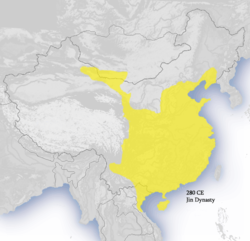Early Jin
| Jin | ||||||||||||||
| 晉 | ||||||||||||||
|
||||||||||||||
|
The Jin Empire (yellow) at its greatest extent, c. 280
(Western Jin) |
||||||||||||||
| Capital |
Luoyang (265–311) Chang'an (312–316) Jiankang (317–420) |
|||||||||||||
| Languages | Middle Chinese | |||||||||||||
| Religion | Buddhism, Daoism, Chinese folk religion | |||||||||||||
| Government | Monarchy | |||||||||||||
| Emperor | ||||||||||||||
| • | AD 265–290(first) | Emperor Wu of Jin | ||||||||||||
| • | 419–420(last) | Emperor Gong of Jin | ||||||||||||
| History | ||||||||||||||
| • | Establishment | 265 | ||||||||||||
| • | Reunification of China under Jin rule | 280 | ||||||||||||
| • | Jin evacuates to region south of the Huai River, Eastern Jin begins | 317 | ||||||||||||
| • | Abdication to Liu Song | 420 | ||||||||||||
| Area | ||||||||||||||
| • | 280 (Western Jin peak) | 3,100,000 km2 (1,200,000 sq mi) | ||||||||||||
| • | 347 (Eastern Jin peak) | 2,800,000 km2 (1,100,000 sq mi) | ||||||||||||
| Population | ||||||||||||||
| • | 300 est. | 35,000,000 | ||||||||||||
| Currency | Chinese coin, Cash | |||||||||||||
|
||||||||||||||
| Today part of |
|
|||||||||||||
| Jin dynasty | |||||||||||||||||||||||||||||

Seven Sages of the Bamboo Grove, a tomb painting from Jiankang (Nanjing) now located in the Shaanxi Provincial Museum.
|
|||||||||||||||||||||||||||||
| Traditional Chinese | |||||||||||||||||||||||||||||
|---|---|---|---|---|---|---|---|---|---|---|---|---|---|---|---|---|---|---|---|---|---|---|---|---|---|---|---|---|---|
| Simplified Chinese | |||||||||||||||||||||||||||||
|
|||||||||||||||||||||||||||||
| Sima Jin | |||||||||||||||||||||||||||||
| Traditional Chinese | |||||||||||||||||||||||||||||
| Simplified Chinese | |||||||||||||||||||||||||||||
|
|||||||||||||||||||||||||||||
| Liang Jin | |||||||||||||||||||||||||||||
| Traditional Chinese | |||||||||||||||||||||||||||||
| Simplified Chinese | |||||||||||||||||||||||||||||
| Literal meaning | Two Jins | ||||||||||||||||||||||||||||
|
|||||||||||||||||||||||||||||
| Western Jin | |||||||||||||||
| Traditional Chinese | |||||||||||||||
|---|---|---|---|---|---|---|---|---|---|---|---|---|---|---|---|
| Simplified Chinese | |||||||||||||||
|
|||||||||||||||
| Eastern Jin | |||||||||||||||

The Jin Empire (yellow), c. 400
(Eastern Jin) |
|||||||||||||||
| Traditional Chinese | |||||||||||||||
|---|---|---|---|---|---|---|---|---|---|---|---|---|---|---|---|
| Simplified Chinese | |||||||||||||||
|
|||||||||||||||
The Jin dynasty or the Jin Empire (/dʒɪn/;Chinese: 晉朝; pinyin: Jìn Cháo, sometimes distinguished as the Sima Jin or Liang Jin) was a Chinese dynasty traditionally dated from AD 265 to 420. It was founded by Sima Yan, son of Sima Zhao who was made Prince of Jin and posthumously declared the founder of the dynasty. It followed the Three Kingdoms period (220-280 AD), which ended with the conquest of Eastern Wu by the Jin.
There are two main divisions in the history of the dynasty. The Western Jin (265–316) was established as a successor state to Cao Wei after Sima Yan usurped the throne, and had its capital at Luoyang or Chang'an (modern Xi'an); Western Jin reunited China in 280, but fairly shortly thereafter fell into a succession crisis, civil war, and invasion by the "Five Barbarians." The rebels and invaders began to establish new self-proclaimed states in the Yellow River valley in 304, inaugurating the "Sixteen Kingdoms" era. These states immediately began fighting each other and the Jin Empire, leading to the second division of the dynasty, the Eastern Jin (317–420) when Sima Rui moved the capital to Jiankang (modern Nanjing). The Eastern Jin dynasty was eventually overthrown by the Liu Song.
...
Wikipedia

